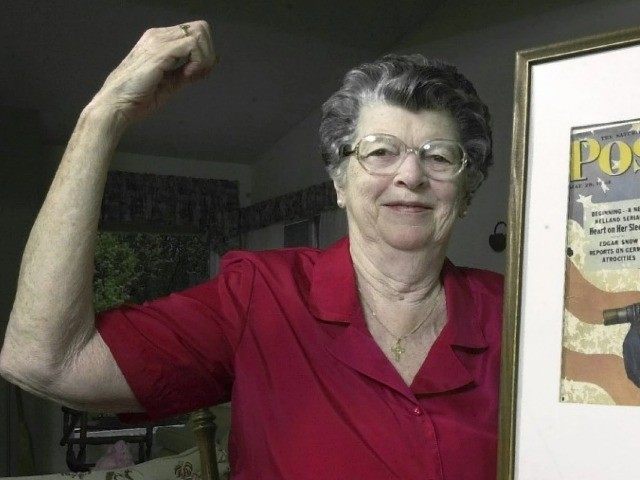Mary Doyle Keefe, the muse for Norman Rockwell’s iconic 1943 “Rosie the Riveter” painting, died Tuesday at The McLean Village Community in Simsbury, Connecticut. She was 92 years old.
The iconic painting helped to represent the millions of American women who went to work in factories and shipyards during World War II, most of whom replaced male workers who had enlisted in the military and were fighting in the war.
Keefe met Rockwell in Arlington, Vermont when she was 19 years old and was working as a telephone operator. She posed for the painting, which was then featured on the cover of The Saturday Evening Post in May 1943.
“I was a telephone operator, 19 years old, and we were neighbors. And [Rockwell] often used neighbors for his paintings,” Keefe told The Courant in 2012. “He liked to paint from photos, so his photographer took pictures of me, just posing me different ways and telling me to look this way or that. I don’t remember the photographer telling me to have any kind of attitude on my face, but I’m 90 and don’t remember.”
Keefe says she was much more petite than Rockwell’s “Rosie the Riveter,” who had broad shoulders with large arms and hands.
“Other than the red hair and my face, Norman Rockwell embellished Rosie’s body,” Keefe explained in the same interview.”I was much smaller than that and did not know how he was going to make me look like that until I saw the finished painting.”
Red-haired Rosie is featured in the painting wearing blue jean overalls with a sandwich in one hand. A rivet gun is placed on her lap and at her feet lies a copy of Adolf Hitler’s manifesto, “Mein Kampf.”
An American flag is waving in the background.
Keefe said she earned $5 both times she posed for Rockwell and his photographer, Gene Pelham.
“You sit there and he takes all these pictures,” Keefe told The Associated Press in 2002. “They called me again to come back because he wanted me in a blue shirt and asked if I could wear penny loafers.”
More than two decades after the iconic painting was released, Rockwell issued a letter of apology to Keefe, writing “I did have to make you into sort of a giant.”
He also called her the most beautiful woman he had ever seen.
The Rosie painting often gets confused with another poster that was made by a Pittsburgh artist in 1942.
This specific one features a woman flexing her arm with the words, “We Can Do It” placed above her. The image was used to boost morale in the workplace. It was later adopted by the feminist movement of the 1980s as a symbol of female empowerment.
“People didn’t make a big deal about things back then,” Keefe told the AP when asked how well received the painting was many years ago.
The original “Rosie the Riveter” painting is now at the Crystal Bridges Museum of American Art in Bentonville, Arkansas.
Keefe was a student at Temple University where graduated with her degree in dental hygiene. She later met her husband of 55 years, Robert Keefe, in Bennington, Vermont, where she worked as a dental hygienist.
Keefe leaves behind four children. Her husband died in 2003.
Her family and friends will hold a memorial mass Friday at McLean Village in Simsbury. She will be laid to rest Saturday at Park Lawn Cemetery in Bennington.
Inspiration for #RosieTheRiveter, of "We can do it!" fame, dies at 92. By @EdPayneCNN: http://t.co/D2jzGzar96 pic.twitter.com/WFc8b8RfCE
— Eliott C. McLaughlin (@ByEliott) April 23, 2015

COMMENTS
Please let us know if you're having issues with commenting.